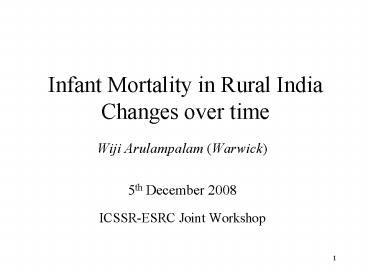Infant Mortality in Rural India Changes over time - PowerPoint PPT Presentation
1 / 27
Title:
Infant Mortality in Rural India Changes over time
Description:
Paper looks at the determinants of infant mortality risk ... In the samples analysed here, approx 12-15% of mothers had experienced at least ... States Analysed ... – PowerPoint PPT presentation
Number of Views:443
Avg rating:3.0/5.0
Title: Infant Mortality in Rural India Changes over time
1
Infant Mortality in Rural India Changes over time
- Wiji Arulampalam (Warwick)
- 5th December 2008
- ICSSR-ESRC Joint Workshop
2
What does the paper do?
- Paper looks at the determinants of infant
mortality risk - How it has changed over time
- In rural India
- Infant mortality death of a child in the first
year of life
3
Motivation (1)
- India first country to launch a family planning
programme in the world. - Provides funding for planned development for
nationwide improvement of health status of
mothers and their children - health education and promotion is an integral
part of all national health and family welfare
programmes.
4
Motivation (2)
- Infant mortality rate in India is still high
compared to many developing countries. - Around 7 of the children born in 2002 died
before reaching their first birthday. - That is 1.69 million infant deaths.
5
Motivation (3)
- Has signed up to the MDG reduce IMR to 27
(deaths per 1000 live births) by 2015. - India contributes nearly 25 of global deaths!
- UN is actively monitoring progress towards MDG
- Need to recognise the high heterogeneity present
in the incidence of infant mortality.
6
The Data
- Indian NFHS 1992/93 1998/99 2005/06
- NFHS 1 2 approx 90,000 ever-married women,
15-49 - NFHS 3 approx 124,000 women, 15-49
- Complete fertility history, record of deaths.
7
The Data contd
- Also had question on infrastructure at the
village level but only in the 1st and the 2nd
round - Female autonomy / decision making in the
household available. - The IMR estimated from the NFHS data are
8
Infant Mortality
9
Motivation (4)
- Need to recognise
- Inter state variations (2004 Kerala 14 Orissa
98) - Intra state variations
- Urban vs Rural (Higher in Rural areas)
- Intra village variations
- Within families CLUSTERING!
- Important for policy purposes to find the cause
of clustering
10
Clustering
- Incidence of childhood death is not randomly
distributed across children or families. - Even after controlling for relevant
socio-economic, behavioural and biological
variables. - In the samples analysed here, approx 12-15 of
mothers had experienced at least one infant death.
11
What drives clustering? (1)
- 1. Heterogeneity between households.
- observed, unobserved
- AND/OR
- 2. Scarring causal process by which the death of
a child predisposes the succeeding sibling to a
higher death risk.
12
What drives clustering? (2)
- Scarring (beneficial) There could be a
positive learning effect for the family from the
experience of a death. - Death of a child ? cessation of breastfeeding ?
mother able to conceive again ? short birth
interval to next child (lt24 months) ? higher
death risk for this child. - Mitigated by the fact that death of the preceding
sibling reduces resource competition and
infection risks for the index child.
13
Problems.
- (1)Sample includes children born across four
decades. - (25 years ago, mothers were 24 years or
younger) - No information on where the mother was resident
at the time of birth or death of children born
some years prior to the survey date.
14
Infant mortality over time (Rural)
15
Observations used in the estimation
16
Prob of infant deaths x 100(children born within
6 years)
17
Model Includes
- (i) Child specific gender, childs birth year,
birth order of the child, mothers age at the
birth of the child - (ii) Family specific state, caste, religion,
education of mother and father - (iii) Household electricity, toilet, water
source - (iv) District level Proportion of women who have
ever used contraceptives, average number of
children in families, proportion of educated
mothers.
18
States Analysed
- AP, Bihar, Gujarat, Haryana, Karnataka, Kerala,
MP, Maharashtra, Orissa, Punjab, Rajastan, TN,
UP, WB and - NE(Assam, Manipur, Meghalaya, Mizoram, Nagaland,
Arunachal Pradesh, Tripura, Sikkim)
19
Descriptives
20
Estimated M.E (x 100)
21
Absence of scarring (Model 1)
22
Summary Conclusions (1)
- Clustering is better explained by
- scarring in 1986-91
- unobserved family frailty in 1992-9
- Both in 1998-05
- There are positive learning in families that
have experienced infant death in the past
(approx 15).
23
Summary Conclusions (2)
- Ceteris paribus
- 86-91 Orissa worst followed by UP. Lowest in
kerala. - 92-97 Bihar, Karnataka, Kerala and NE states are
relatively better. - 98-06 Haryana relatively better.
24
Summary Conclusions (3)
- Ceteris paribus
- 98-06
- Prob of infant death lower in children in
families - Mother has completed primary or better
- Father has completed primary or better
- Piped water or private well
- Mother belongs to the SC/ST/OBC
- Mother is non-Hindu
- Last 8 years have seen a reduction of about 2.3
deaths per thousand per year.
25
Other Current Research
- Gender bias in infant deaths
- Female autonomy and
- education outcome of children
- malnutrition
26
(No Transcript)
27
Model Prediction































